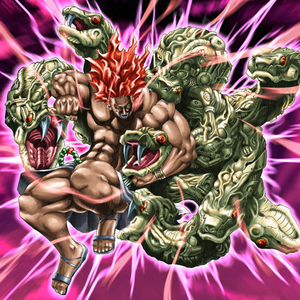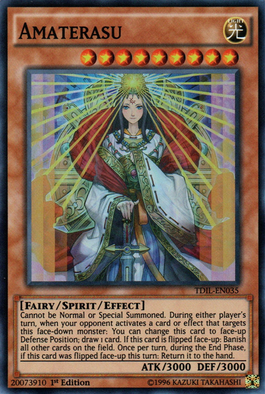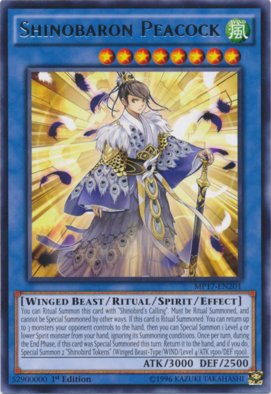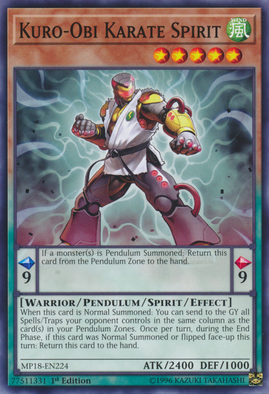Spirit monster
Spirit monsters (スピリットモンスター Supiritto monsutā) are Effect Monsters with the ability "Spirit". Usually, they cannot be Special Summoned, and have an effect that returns them to the hand during the End Phase of the turn they are Normal Summoned or flipped face-up (or the turn they are Special Summoned, in case of Spirit monsters that must be Special Summoned). They debuted in Mythological Age and first received support in The Duelist Genesis, almost 7 years later.
The designs of most Spirit monsters are based on beings from Eastern mythology, primarily Japanese ones. They all have very similar purple backgrounds, and often feature onibi lights on their card artworks.
There are no archetypes focused on Spirit monsters, but the Shinobird and Martial Art Spirit series do. While most Spirit monsters are not members of an archetype, a few Spirit monsters belong to the "Ice Barrier" ("Sacred Spirit of the Ice Barrier") and "Gishki" ("Gishki Natalia" and "Emilia") archetypes, both of which exist in the Duel Terminal card storyline; these Spirit monsters are not based on mythological figures, but instead represent revived spirits of deceased characters in their storyline.
Contents
Characteristics[edit]
[edit]
Most Spirit monsters share the following two effects:
- Cannot be Special Summoned.
- Once per turn, during the End Phase, if this card was Normal Summoned or flipped face-up this turn: Return it to the hand.
The effect to return to the hand during the End Phase only activates during the turn they are Normal Summoned or flipped face-up. If they do not return to the hand in that End Phase (such as due to "Dimensionhole" or "Forbidden Chalice"), this effect does not activate in subsequent turns. If a Spirit monster with this effect was Special Summoned face-up (which would usually require an effect that ignores the Summoning conditions), then this effect does not activate, as it was not Normal Summoned or flipped face-up.
These effects are not universal among all Spirit monsters. Notable exceptions include:
- The Martial Art Spirits can be Special Summoned. They return to the hand during the End Phase of the turn they were Normal Summoned or flipped face-up, like most Spirit monsters.
- "Yamato-no-Kami", "Konohanasakuya", and the Shinobird Ritual Monsters cannot be Normal Summoned/Set; they must be Special Summoned by their own Summoning procedure or Ritual Summon. They return to the hand during the End Phase of the turn they were Special Summoned.
- "Amaterasu" cannot be Normal or Special Summoned; it must be Normal Set, and it still returns itself to hand during the End Phase of the turn it is flipped up.
Design[edit]
Most Spirit monsters are based on specific beings from Oriental mythology, which includes both Japanese Yōkai and various other Asian folklore. The only Spirit monsters not specifically based on Oriental mythology are the Martial Art Spirits, and the Spirit monsters belonging to the Duel Terminal storyline. The Shinobird series is, as a whole, based on the story of the Tanabata.
Most of these Spirit monsters' Japanese names are written in kanji with furigana written in katakana; this is a reference to how Japanese orthography commonly writes the names of major Japanese kami in katakana.
| Spirit monster | Origin |
|---|---|
| Konohanasakuya | Konohanasakuya-hime |
| Amaterasu | Amaterasu |
| Hino-Kagu-Tsuchi | Kagutsuchi |
| Yamata Dragon | Yamata no Orochi |
| Dark Dust Spirit | Shinigami |
| Yamato-no-Kami | Susanoo and the heads of Yamata no Orochi |
| Fenghuang | Fenghuang or "Hou-Ou" |
| Great Long Nose | Red Nose Tengu |
| Susa Soldier | Susanoo and Kusanagi-no-Tsurugi |
| Yaksha | Yaksha |
| Rasetsu | Rakshasa |
| Amano-Iwato | Ama no Iwato |
| Hebo, Lord of the River | Kappa or Hebo |
| Asura Priest | Asura |
| Maharaghi | Shakoukidoguu |
| Fushi No Tori | Phoenix |
| Izanami | Izanami |
| Tsukuyomi | Tsukuyomi |
| Gundari | Kuṇḍali |
| Aratama, Nikitama, and Sakitama | Mitama |
| Inaba White Rabbit | Hare of Inaba |
| Otohime | Oto-hime |
| Yata-Garasu | Three-legged crow |
| Kinka-byo | Bakeneko |
| Support card | Origin |
|---|---|
| Izanagi | Izanagi |
| Mirror of Yata | Yata no Kagami |
| Sword of Kusanagi | Kusanagi no Tsurugi |
| Orb of Yasaka | Yasakani no Magatama |
Playing style[edit]
Spirit monsters, as an individual Spirit-focused deck, are focused on overcoming their negative self-restrictions, and utilizing Spirit support cards to bring out powerful individual Spirit monsters and use their strong effects in the one turn they stay on the field. Due to their Main Deck nature and Special Summoning restriction, Spirit-focused Decks are primarily focused on Normal and Tribute Summoning; however, Spirit Decks focused on the Shinobird Ritual Spirit boss monsters focus on Ritual Summoning instead.
While Spirit monsters can be played as staple monsters in historical Decks due to having relatively strong effects that made up for their negative effects (relative to their contemporaries), most Spirit monsters have become obsolete as the metagame progressed.
Spirit monsters have a wide variety of effects. Key Spirit monsters that provide consistency include "Aratama", a monster searcher, "Nikitama" and "Sakitama", who grant extra Normal Summons to Spirits, and "Konohanasakuya", a Special Summon extender with a GY effect to let a Spirit monster stay on the field (by preventing its return-to-hand effect from activating).
Major Spirit boss monsters include the following:
- "Hino-Kagu-Tsuchi" empties the opponent's entire hand before their Draw Phase if it inflicts battle damage.
- "Yamata Dragon" fills its controller's hand with up to 5 cards if it inflicts battle damage.
- "Dark Dust Spirit" destroys all other face-up monsters when Normal Summoned.
- "Fenghuang" destroys all of the opponent's Set Spell/Traps when Normal Summoned.
- "Amaterasu", which can only be Set, will Banish every card on the field other than itself if it flips face-up.
- "Amano-Iwato", which prevents all non-Spirit monsters from activating their effects. It is arguably the most powerful Spirit boss monster, as it can be easily summoned, and provides a strong continuous lockdown effect, providing real field presence in the opponent's turn if the player manages to have "Amano-Iwato" stay on the field.
The Ritual Spirit monsters "Shinobaron Peacock" and "Shinobaroness Peacock", despite their status as Ritual monsters, are arguably the most accessible, powerful, and relevant Spirit monsters in the game. Being Ritual monsters, they have access to large amounts of Ritual support, including the powerful "Pre-Preparation of Rites". Their Ritual Spell, "Shinobird's Calling", can use GY Spirit monsters as resources for their Ritual Summon. Once Summoned, they can both remove up to 3 opposing cards and Special Summon a Spirit monster ignoring its Summoning conditions (typically "Amano-Iwato", which will stay on the field), and after they return to the hand in the End Phase, will float into two tokens. These two Ritual monsters are easily accessible and instantly provide removal and board presence upon hitting the field, making them extremely effective Spirit boss monsters.
In terms of supportive Spell/Traps, Spirits lack efficient consistency Spell/Traps, and mostly have obsolete battle-focused Spell/Traps or conditional card effects that remove their self-return effects. Two Spirit support Spell/Traps that still have some relevancy are "Shinobird Power Spot", which provides stat boosts and conditional searches, and "Shinobird Salvation", which destroys an opposing card when a Spirit monster returns to the hand.
Recommended cards[edit]
Recommended cards
| ||
|---|---|---|
|
Weaknesses[edit]
- Despite having several strong boss monsters, the lack of consistency support for Spirit monsters, and their inability to swarm the field for combo plays, still makes it difficult to quickly summon Spirit boss monsters. Most Spirit decks thus play extremely slowly, and their plays can be easily disrupted.
- Because Spirit monsters have return to the hand during the End Phase, Spirit Decks have very little field-staying power, leaving the player's board wide open to the opponent's attacks.
- "Rivalry of Warlords" and "Gozen Match" can slow this deck down, since Spirit monster Decks typically uses Spirits of different Types and Attributes.
Examples[edit]
Effect Spirit Monster ("Amaterasu")
Ritual Spirit Monster ("Shinobaron Peacock")
Pendulum Spirit Monster ("Kuro-Obi Karate Spirit")
In the anime[edit]
In the Yu-Gi-Oh! anime, in episodes 117 and 118, Noah Kaiba used Spirit monsters in his duel against Yami Yugi. According to him, the Spirit monsters were created by Maximillion Pegasus when he was traveling to Eastern Asia and drew inspiration from the religions and mythologies from that region.
In Yu-Gi-Oh! GX and Yu-Gi-Oh! ARC-V, "Asura Priest" and "Dark Dust Spirit" had cameo appearances, in episodes 111 and 21, respectively.
Trivia[edit]
- All Pendulum Spirit Monsters in the game are part of the "Martial Art Spirit" series.
- They are the only Spirit Monsters that can be Special Summoned under any given circumstances, in which case it does not trigger their effect that returns them to the hand.
- The Spirit monster "Yata-Garasu" is infamous for its complete lockdown of the opponent's hand when combined with "Chaos Emperor Dragon - Envoy of the End"; thus, Yata-Garasu was Forbidden from 2004 until 2022.
- "Izanagi" is the only non-Spirit Monster that has Spirit World in its background and is the only non-Spirit Monster that directly supports Spirit Monsters.
- "Soul Resurrection" is the only card that has the Spirit World in its background with absolutely no relation to Spirit Monsters.
- The effect that returns Spirit Monsters to the hand, as well as their transparent appearance, may be a reference to them not being able to stay on the physical plane for long.



